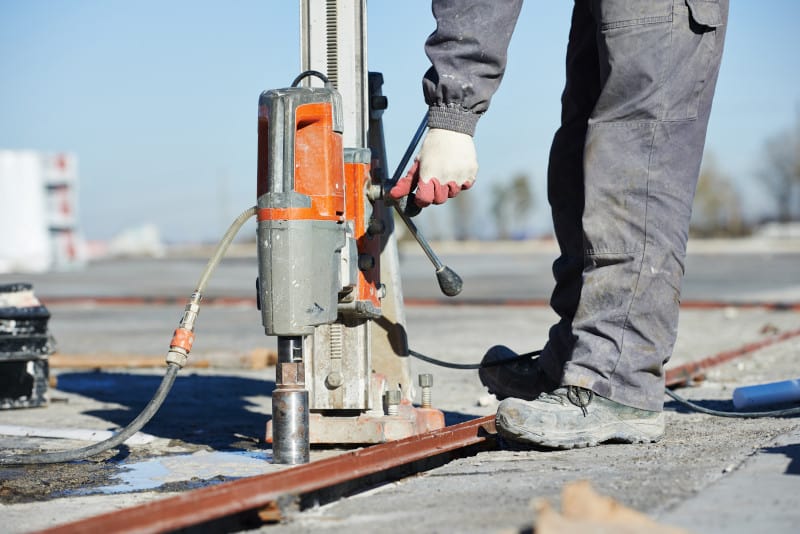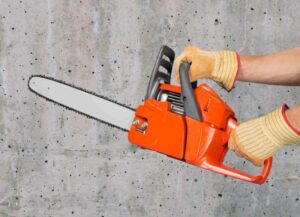If you have to drill a hole through concrete, concrete core bits are the tool for the job. But often these don’t come with instructions, and you might be wondering how to use a concrete core drill. We have developed a simple guide to help you use a core drill:
12 Steps in How To Use a Core Drill
- Survey the site and check for hazards such as sewer lines, electrical lines, or gas line
- Put on your PPE including safety glasses and mask
- Connect the diamond core drill bit to the core drill machine
- When core drilling without a pilot bit place your template in position; OR
- For core drilling WITH a pilot bit insert your SDS bit; OR
- When core drilling with a stand, anchor your stand to the flooring or wall
- For wet core drilling connect your water source
- Position your core drill onto the material
- Drill through the material starting slowly
- Keep your core drill straight – you may need to move it up and down to release dust
- Go slow if you hit reinforcements like rebar
- Remove your core drill.
Whether you’re using the tool on a larger construction site or fixing up a DIY project, there are a few more essential details to keep in mind that we will explore further.
Continue reading to find out more…
What is a Core Drill Used For?
A core drill is a drill used to remove a cylinder of material. In this sense, it resembles a hole saw!
Core drills, depending on their size, function, and power, can be used for home projects. Here the drill is needed to bore through hard surfaces like concrete, brick, or porcelain tiles.
A core drill, when attached to a diamond core drill bit, produces deep, clean holes that can’t be achieved by a standard drill. Common purposes include making holes for laying waste pipes or electrical wires.
In other industries, core drills are used to take samples of minerals out of rock or to test layers and the depth of a rock and oil source.
How Do You Use a Concrete Core Bit?
As you get ready to start drilling, heed the advice below:
Attaching the Diamond Core Drill Bit
Before you start drilling, you need to make sure the diamond core bit is securely attached to the drill!
Turn the core drill bit in an anti-clockwise direction and tighten it by hand. The core drill bit will lock itself in place once you begin drilling. You should always align the drill bit with the location of the hole. A friend can help you hold the drill in place.
Ensure you’ve selected the right size of the diamond core barrel for the material you are drilling. You should also double-check you’ve chosen the right machine, speed, and horsepower. Check the diamond core barrel for any damage before use.
Survey the Work Site
Have a precise plan of where you are going to drill. You should always make sure to find out whether there are any rebar, sewer lines, electrical lines, or gas lines where you are drilling. Always double-check the precise spot.
Harming wires and pipes could be dangerous at worst. At best, it will cause great inconvenience and repair work.
Identify onsite hazards to make sure you can prevent risks. Before you start, mark the mounting area with a pencil and take your core drill into an area where you have sufficient space to work.
Core Drill Equipment
A core drill and a concrete core bit are not the only pieces of equipment you may need to complete a project at home. The following list covers most of what you will need when coring concrete:
- a core drill machine
- the diamond core drill bit
- core drill pilot SDS bit (optional)
- a stand for your core drill (optional – very common)
- core drill template (optional)
- water (optional, depending on your core drill bit, but preferred by most)
- protective eyewear
- dust mask
Staying Safe While Using Concrete Core Bits
Safety is paramount during any construction project!
While using a concrete drill, you should always be wearing safety goggles or glasses. Concrete fragments and dust might be flung into your eyes otherwise.
There’s also a risk of the concrete bit shattering and being flung outward, which could present a severe threat to your eyes. Large fragments could blind you permanently, so take every caution to protect your eyes when using a concrete core bit.
If you’re using a dry drill, or if you anticipate a lot of dust, you should also check out our P2 masks for sale to filter the air you breathe. Silica dust, even though it may be in a slurry, can cause health problems.
How to Core Drill Through Concrete
Before you start drilling, you should always read the instructions provided with the drill and core bit to make sure you are following the manufacturer’s guidelines.
There’s no one guide to cover all types of drill bits that work for all sites, conditions, and drills, however, some general guidelines can be minded.
While drilling through concrete, it is crucial to keep the drill as straight as possible! This prevents the bit from being destroyed. It also avoids elongating the hole you are drilling.
If the drill leans at too much of an angle, the hole might widen and need patching. The resulting finish would not be as stable as concrete and could cause fixtures and anchors you install to loosen with time.
If you’re after smaller holes, you can connect smaller sized core bits to a regular rotary hammer or hammer drill. Special water attachments can be purchased to fit on your hammer drill, contact us to order one.
The heavy duty dedicated core drill machines is necessary for more significant concrete bits. If you’re hand drilling, you can create a template out of wood and pin it to the wall. Alternatively, if you’re floor drilling, stand on the template to position yourself. This guide will help you keep the barrel in the right place.
Most professionals use a core drill stand also known as a core drill rig. This allows you to not only core directly through the wall and floor, but also at precise angles. Therefore creating diagonal core holes.
Can a Core Drill Cut Through Rebar?
Rebar is reinforced steel that’s either a bar or a mesh of steel wires used to support concrete and masonry structures. This is used because although concrete is strong under compression, it has weak tensile strength.
Builders rarely leave an indication of the location of the rebar. So when you drill through reinforced concrete, your drill bit might encounter metal. You’ll usually notice when you hit rebar because the water colour changes.
Core drills can cut through rebar with relative ease. When you hit steel, slow down your drill and proceed cautiously.
Can You Core Drill Without Water?
Drilling without water is possible and referred to as dry core drilling. This method is used more rarely but does have its purposes. For example, if you are drilling near electrical wires or through soft brick, drilling without water is a good choice.
In other circumstances, drilling without water usually puts more stress and pressure onto the blades and may cause the drill speed to decrease. Wet drilling will leave the hole more durable and clean, as fewer fragments are left behind.
Also, the water will help control how much dust is flushed out by the cut, which can help the drill last longer. In most cases, wet core drilling is therefore preferred to a dry approach.
How to Remove the Bit From the Core Drill
Safely remove the concrete core bit by first turning down the water. Back the bit out while the motor is still running.
Other Tips…
Never work off ladders, crates, drums, or chairs and always use proper access equipment. Also avoid working on slippery floors, unstable, or uneven surfaces. The user should be well balanced while holding the drill.
Adopt the correct grip and stance as the barrel will turn clockwise and you may need to counter the rotational forces. Core drills can also be cumbersome and difficult to handle.
Ensure there is adequate lighting and keep a fire extinguisher and first aid kit nearby just in case.
Prolonged drilling could lead to vibration fatigue, so be aware of this risk and how to manage it. Take regular breaks and stop if you are feeling unsteady or like your arms are tiring.
The risk of harm increases when working out of sight of other people, so try not to work alone. Never leave a running machine unattended.
Where to buy a Core Drill Bit
Did you know that when it comes to core drill bits we have you covered. With sizes from 18mm to greater than 166mm. Just give us a call and we can let you know what is best for your job.
Ready to Use Your Concrete Drill Bit?
A core drill bit functions much like other drills and can be a nifty tool for both large construction projects and at-home DIY. As the drill is substantial with great rotational force, it’s imperative to observe safety guidelines.
This guide should have provided you with the answer to the question: How do you use a concrete core bit?
However, no two environments or tasks are quite the same, so familiarise yourself with your worksite, assess the risks, and read the instructions provided with your core drill!
For more information, please feel free to contact our friendly team of professionals. We’re always happy to help. Speak soon!





You could definitely see your enthusiasm in your writing
Appreciation to my father who shared with me this weblog, this web site is truly remarkable.